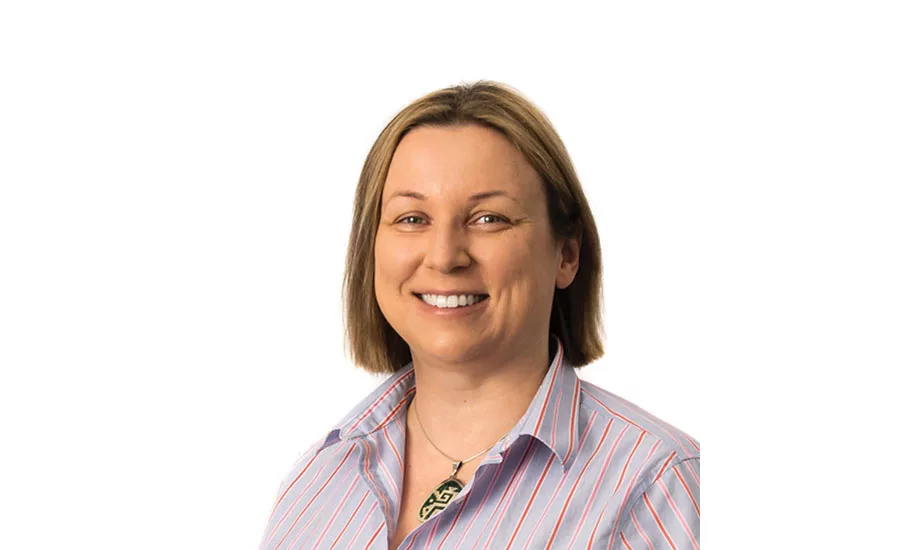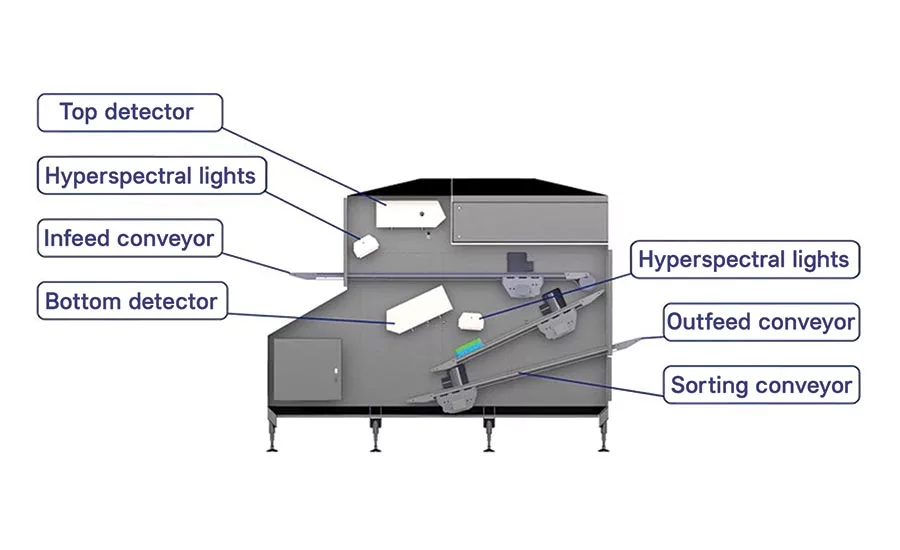Engineering R&D
Spectroscopy monitors chemistry, surface-level foreign objects in real time

Olga Pawluczyk, P&P Optica president and CEO

PPO’s Smart Imaging System assesses quality measures including tenderness, fat/lean and water content. Plus, it identifies foreign objects at line speed.
Sophisticated, high-end spectroscopy systems are no longer relegated to the lab environment. Thanks to high-performance computing systems, improved cameras and highly developed algorithms, this once lab-only technology has made it on production lines scanning food products for chemical constituents, such as fats and proteins in meats and moisture and chlorophyll levels in produce. It can also check for surface-level foreign bodies, such as metals, plastic and rubber—things some inspection systems miss.
Relatively new to our industry, P&P Optica (Waterloo, Ontario) began life as a consulting and research firm to several industries. For the last five years, it has delved into creating a high-end, hyperspectral imaging system that can operate in real time on lines for products such as meat and produce. Through an IBM-sponsored project, P&P Optica has successfully tested a system at Maple Leaf Foods in Brandon, Manitoba.
Olga Pawluczyk, president and CEO, has been the driving force in bringing the P&P Optica Smart Imaging System to reality, with her background with spectroscopy and X-ray technologies in the medical field.
This technological acumen runs in the family. Her father, Romuald Pawluczyk, has developed high-sensitivity spectroscopy systems for many years, and together they share several patents. It’s the high sensitivity that allows these machines to run at line speed.
But what sets these systems apart from a typical laser-based, single-component (chemical) scanner or optical sorter is their wide-band coverage of light, allowing them to measure simultaneously all the chemicals contained in a sample as it passes by.
“We’re able to collect all wavelengths in a hyperspectral configuration, so we have hundreds or thousands of wavelengths that we can always be analyzing,” says Pawluczyk. “So today, we can assess potatoes; tomorrow, blueberries; the day after, chicken—and the underlying spectral system is identical. Because we can see all chemical signatures, we can apply it to do many things at the same time.”
FE: P&P Optica has been involved with other industries. What prompted the move to food and beverage?
Olga Pawluczyk: When we started considering industrial applications, we looked at many sectors: oil and gas, medical, even space. In fact, one of our spectrometers is on the space station right now! The opportunity to work in an industry that touches every single person on the planet was very exciting. We know that we can solve many of the challenges food processors face every day, and we can do it in a unique way.
FE: P&P Optica was part of the IBM Innovation Incubator Project. How did this work, and what were the benefits?
Pawluczyk: We were part of the Customer Demonstration Project with IBM. They provided us with cloud technology that, together with our Smart Imaging System, allowed us to run a proof-of-concept test with the Maple Leaf Foods plant in Brandon, Manitoba. We were able to demonstrate that our system met Maple Leaf’s high standards for detection of foreign objects. IBM’s analytics capabilities allowed us to process the high volumes of data we needed to manage, at the processing speeds we needed to achieve to operate in real time.
FE: Could you explain how the system works?
Pawluczyk: PPO is a food information company. Our Smart Imaging System can “see” the chemical makeup of the food with patented technology called hyperspectral imaging, which uses the properties of light to understand food chemistry.
Our hyperspectral lights shine down on the food as it passes by at line speed. The light is then reflected up into our spectrometer, which analyzes the reflected image pixel by pixel. Each pixel contains information about thousands of bands of light, and we analyze that information using artificial intelligence and machine learning.
Our AI engine can quickly determine the chemical composition of the objects that are passing by the detector module and can provide immediate information about the composition and quality of the food it sees. It can also immediately identify foreign objects on the food and can then make an instant rejection decision.
FE: What is the software component of the system?
Pawluczyk: Our Smart Imaging System includes a number of software components. We have an HMI (human-machine interface) that tells the machine operator what’s happening while the system is operating on the line.
Our artificial intelligence engine operates at line speed in the plant and makes instantaneous decisions about the food that is being processed, based on parameters that are established by our clients. We offer software modules that can evaluate different chemical properties of food and detect foreign objects. Our AI engine is trainable, meaning it can learn to identify new foreign objects or evaluate new chemical properties of food using the same hardware with a new software upgrade.
Finally, we offer our clients a web interface that provides over-time information and analytics. This helps our clients to identify patterns and address risk areas, so they can better manage their plants and their suppliers and provide high levels of confidence to their customers.
FE: Besides fat and protein, what other variables in meat could be monitored?
Pawluczyk: We can precisely measure the fat/lean composition of blends of meat and assess chemical or even physical properties, such as tenderness, water content and pH. We can help processors identify issues such as woody breast in poultry or boar taint in pork. And we can identify foreign objects down to very small tolerances. Essentially, if there is any difference in the chemistry of desirable and undesirable samples, we can detect that.
FE: Could this technology be applied to fish and seafood?
Pawluczyk: We haven’t specifically tested our system with fish, but we know that there are chemical differences between cold-water and warmer-water fish, as well as between saltwater and freshwater fish. Based on that, our system should be able to identify different types of fish by their chemical properties. We have also been able to find shells in seafood, such as lobster or shrimp.
FE: What variables in produce could be monitored?
Pawluczyk: Our system can monitor properties such as freshness, shelf life, sugar content and nutritional value. In addition to finding foreign objects, including metals or plastics, our system can identify small, similarly colored contaminants, such as frogs on spinach, which would be extremely difficult to identify using a vision system, such as a camera, or human inspection.
FE: Could wineries find this system useful in monitoring grapes?
Pawluczyk: There are a number of properties of grapes that our system could measure based on chemical differences: sugar content, ripeness and dryness, for example. We can also easily separate stems from small rocks from grapes, as the grapes are being processed.
FE: How easy is it to set up the system?
Pawluczyk: We’re set up to do thorough pre-installation testing in our facilities in Waterloo, Ontario. In fact, we do a full acceptance test with our clients before a new system ever leaves our facility and work very closely with our clients’ engineering teams to work out all the interfaces between our system and the processing plant. We work with the client to install the system at a time that minimizes disruption on the line.
FE: When is the system generally available and for what food types?
Pawluczyk: Today, our focus is on the meat industry; we believe that if we can meet their needs, we can serve other food sectors easily and effectively. Frankly, because of the very stringent cleanliness requirements, meat processing is one of the most challenging areas of food processing. We have chosen to solve the more difficult in-line problem first, knowing that will make it relatively easier to make our system work for other food types in the future. We’re accepting commercial orders, with a six month approximate delivery timeline.
For more information, visit www.ppo.ca
Looking for a reprint of this article?
From high-res PDFs to custom plaques, order your copy today!






